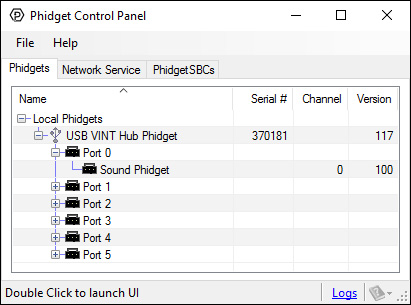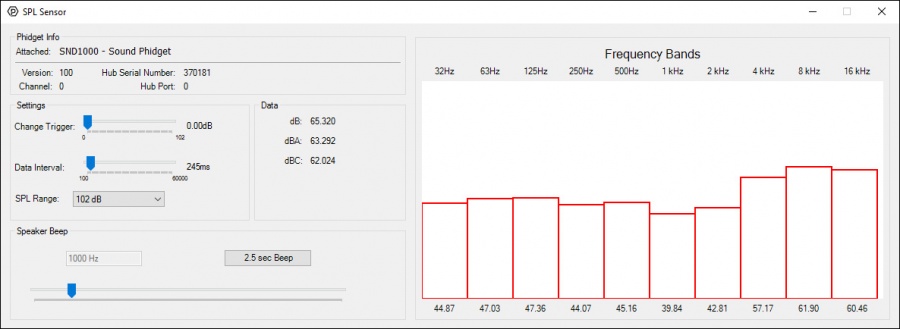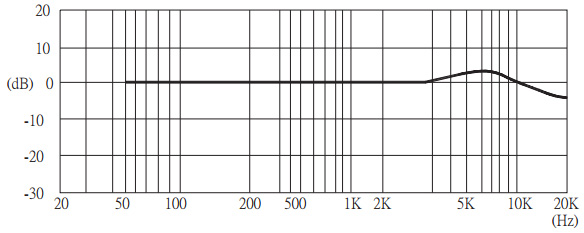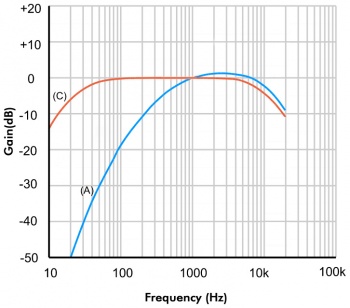SND1000 User Guide: Difference between revisions
No edit summary |
No edit summary |
||
| Line 1: | Line 1: | ||
__NOINDEX__ | |||
<metadesc>The Sound Phidget measures sound from 34 to 102 dB (SPL), supports A and C weightings, and can split data into distinct frequency bands. </metadesc> | <metadesc>The Sound Phidget measures sound from 34 to 102 dB (SPL), supports A and C weightings, and can split data into distinct frequency bands. </metadesc> | ||
[[Category:UserGuide]] | [[Category:UserGuide]] | ||
Revision as of 20:23, 8 May 2018
Getting Started
Welcome to the SND1000 user guide! In order to get started, make sure you have the following hardware on hand:
- SND1000 - Sound Phidget
- VINT Hub
- Phidget cable
- USB cable and computer
Next, you will need to connect the pieces:

- Connect the SND1000 to your VINT Hub using the Phidget cable.
- Connect the VINT Hub to your computer using the USB cable.
Now that you have everything together, let's start using the SND1000!
Using the SND1000
Phidget Control Panel
In order to demonstrate the functionality of the SND1000, the Phidget Control Panel running on a Windows machine will be used.
The Phidget Control Panel is available for use on both macOS and Windows machines.
Windows
To open the Phidget Control Panel on Windows, find the ![]() icon in the taskbar. If it is not there, open up the start menu and search for Phidget Control Panel
icon in the taskbar. If it is not there, open up the start menu and search for Phidget Control Panel
macOS
To open the Phidget Control Panel on macOS, open Finder and navigate to the Phidget Control Panel in the Applications list. Double click on the ![]() icon to bring up the Phidget Control Panel.
icon to bring up the Phidget Control Panel.
For more information, take a look at the getting started guide for your operating system:
Linux users can follow the getting started with Linux guide and continue reading here for more information about the SND1000.
First Look
After plugging the SND1000 into your computer and opening the Phidget Control Panel, you will see something like this:

The Phidget Control Panel will list all connected Phidgets and associated objects, as well as the following information:
- Serial number: allows you to differentiate between similar Phidgets.
- Channel: allows you to differentiate between similar objects on a Phidget.
- Version number: corresponds to the firmware version your Phidget is running. If your Phidget is listed in red, your firmware is out of date. Update the firmware by double-clicking the entry.
The Phidget Control Panel can also be used to test your device. Double-clicking on an object will open an example.
Sound Sensor
Double-click on the Sound Sensor object, labelled Sound Phidget, in order to run the example:

General information about the selected object will be displayed at the top of the window. You can also experiment with the following functionality:
- Modify the change trigger and/or data interval value by dragging the sliders. For more information on these settings, see the data interval/change trigger page.
- Use the SPL Range drop-down menu to select the lowest possible range that the level of sound you're measuring will fall within (smaller ranges have higher resolution).
- Use the Speaker Beep tool to emit a 2.5 second beep of the specified frequency. View the frequency bands and see how they respond.
Technical Details
Acoustic Weightings
Depending on your application, you may be interested in acoustic data with weightings applied. The SND1000 returns a SPL value with the A-weighting applied, C-weighting applied, and with no acoustic weighting applied.
Sensitivity
The microphone on the SND1000 is slightly more responsive to some frequencies than others. The following graph illustrates this difference:

What to do Next
- Programming Languages - Find your preferred programming language here and learn how to write your own code with Phidgets!
- Phidget Programming Basics - Once you have set up Phidgets to work with your programming environment, we recommend you read our page on to learn the fundamentals of programming with Phidgets.

